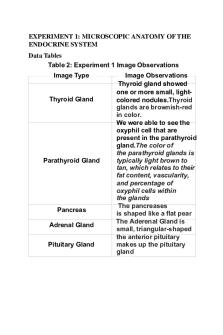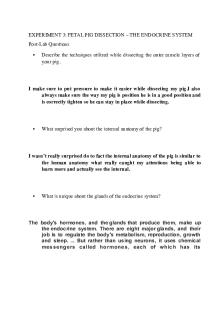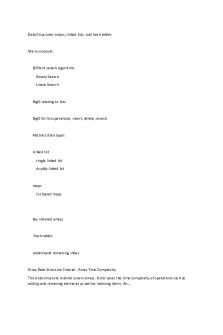Experiment 1 Data Tables and Assessment(1)-6 PDF

| Title | Experiment 1 Data Tables and Assessment(1)-6 |
|---|---|
| Author | ania ojeda |
| Course | Professional Nursing I |
| Institution | Florida International University |
| Pages | 4 |
| File Size | 113.7 KB |
| File Type | |
| Total Downloads | 64 |
| Total Views | 139 |
Summary
helpful for nursing school...
Description
EXPERIMENT 1: MICROSCOPIC ANATOMY OF THE ENDOCRINE SYSTEM Data Tables Table 2: Experiment 1 Image Observations Image Type
Thyroid Gland
Parathyroid Gland
Pancreas Adrenal Gland Pituitary Gland
Image Observations !Thyroid gland showed one or more small, lightcolored nodules.Thyroid glands are brownish-red in color. We were able to see the oxyphil cell that are present in the parathyroid gland.The color of the parathyroid glands is typically light brown to tan, which relates to their fat content, vascularity, and percentage of oxyphil cells within the glands The pancreases is shaped like a flat pear The Aderenal Gland is small, triangular-shaped the anterior pituitary makes up the pituitary gland
Anterior Pituitary Gland
The pituitary gland is small and oval-shaped its located behind are nose
Post-Lab Questions •
Identify the indicated components in the slide image below. A_______Collied___________ B______ Extrafollicular Cells____________
•
Identify the indicated components in the slide image below. A____Chief Cells______________
•
Identify the indicated components in the slide image below. A_____Capillary_____________
•
What is a hormone?
Hormones are chemical messengers that travel
throughout the body coordinating complex processes like growth, metabolism, and fertility. ... In response to a signal from the brain, hormones are secreted directly into the blood by the glands that produce and store them.
•
How do hormones establish selectivity?
Hormones are ligands that bind to specific cells that express themselves with specific receptors. The hormones binds to the receptors by forming complexes with them which then acquires a certain purpose. Explanation: Body cells that do not have these receptors or do not express the receptors never get the signal.
•
Explain how insulin regulate glucose levels in the blood.
Insulin helps control blood glucose levels by signaling the liver and muscle and fat cells to take in glucose from the blood. Insulin therefore helps cells to take in glucose to be used for energy. If the body has sufficient energy, insulin signals the
liver to take up glucose and store it as glycogen....
Similar Free PDFs

Tables (Design Data) 313
- 58 Pages

Experiment 7 Data Observations
- 4 Pages

Chem111 Experiment 3 Data
- 3 Pages

Wills and Administration Tables
- 3 Pages

Truth Tables and Tautology
- 3 Pages

Formula sheet and tables
- 101 Pages

Triola Formulas And Tables
- 8 Pages
Popular Institutions
- Tinajero National High School - Annex
- Politeknik Caltex Riau
- Yokohama City University
- SGT University
- University of Al-Qadisiyah
- Divine Word College of Vigan
- Techniek College Rotterdam
- Universidade de Santiago
- Universiti Teknologi MARA Cawangan Johor Kampus Pasir Gudang
- Poltekkes Kemenkes Yogyakarta
- Baguio City National High School
- Colegio san marcos
- preparatoria uno
- Centro de Bachillerato Tecnológico Industrial y de Servicios No. 107
- Dalian Maritime University
- Quang Trung Secondary School
- Colegio Tecnológico en Informática
- Corporación Regional de Educación Superior
- Grupo CEDVA
- Dar Al Uloom University
- Centro de Estudios Preuniversitarios de la Universidad Nacional de Ingeniería
- 上智大学
- Aakash International School, Nuna Majara
- San Felipe Neri Catholic School
- Kang Chiao International School - New Taipei City
- Misamis Occidental National High School
- Institución Educativa Escuela Normal Juan Ladrilleros
- Kolehiyo ng Pantukan
- Batanes State College
- Instituto Continental
- Sekolah Menengah Kejuruan Kesehatan Kaltara (Tarakan)
- Colegio de La Inmaculada Concepcion - Cebu








